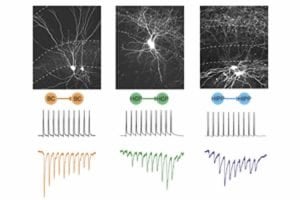Diversity of inhibiting nerve cells allows for more complex information processing.
The hippocampus is a small structure in the brains of mammals that plays a crucial role in processing input from our senses and allows perceptions to be stored as memories. Nerve cells that inhibit the activity of other cells have now been shown to play a much larger and more complex role in these processes than previously assumed. Teams led by Prof. Dr. Marlene Bartos from the Cluster of Excellence BrainLinks-BrainTools at the University of Freiburg and Prof. Dr. Imre Vida from the Cluster of Excellence NeuroCure at the hospital Charité in Berlin report these findings in the current issue of the Journal of Neuroscience.

In their study, the scientists investigated how special types of so-called interneurons build connections with each other within the hippocampus and how their function influences the network of nerve cells as a whole. Interneurons do not prompt other nerve cells to become active but, on the contrary, inhibit them. This kind of suppression plays an important role in brain activity in general. Information processing would not be possible otherwise, because a brain in which all nerve cells are active at the same time is effectively put out of order.
The hippocampus is home to a variety of different inhibitory cells, which were known so far to differ greatly in their form and function. But up to now it has been generally assumed that their actual influence on the activity of the brain structure they belong to is rather small. By combining several different experimental methods, Bartos, Vida, and their teams succeeded in showing that these cells are actually able to strongly interfere with the activity and the timing of activity patterns within the hippocampus. Moreover, the various possible combinations of connections between these different cell types show markedly different characteristics in their function. This makes the inhibition within the hippocampus much more flexible and versatile than previously assumed. The team of scientists suspects that this also makes the capability to process information within the hippocampus much bigger. The results published in this study are from experiments conducted in acute slice preparations of the hippocampus. Up next for the researchers will be the task of verifying these results within the actual brain.
Contact: Marlene Bartos – Albert Ludwigs University of Freiburg
Source: Albert Ludwigs University of Freiburg press release
Image Source: The image is credited to BrainLinks-BrainTools and is adapted from the Albert Ludwigs University of Freiburg press release
Original Research: Abstract for “Synaptic Properties of SOM- and CCK-Expressing Cells in Dentate Gyrus Interneuron Networks” by Shakuntala Savanthrapadian, Thomas Meyer, Claudio Elgueta, Sam A. Booker, Imre Vida, and Marlene Bartos in Journal of Neuroscience. Published online June 11 2014 doi:10.1523/JNEUROSCI.5433-13.2014






